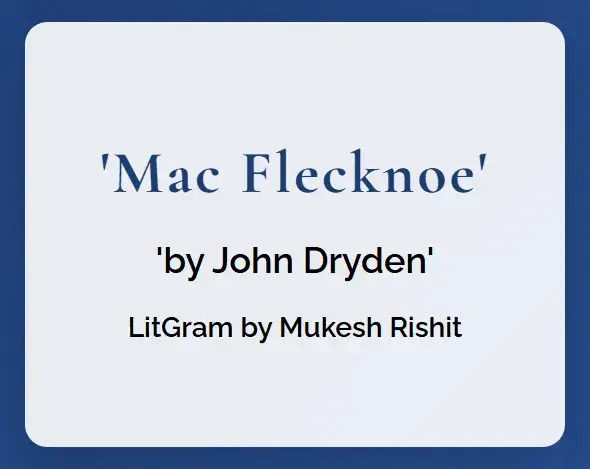Introduction
Mac Flecknoe is one of the most cutting pieces of literary satire ever penned in English literature. Written by John Dryden around 1678 and published in 1682, this mock-heroic poem delivers a devastating critique of Thomas Shadwell, a contemporary playwright whom Dryden considered an inferior writer. The poem cleverly chronicles the “coronation” of Shadwell (given the name Flecknoe in the poem) as the king of dullness and literary incompetence.
What makes this work particularly fascinating is how Dryden skillfully employs elevated heroic couplets to ridicule his target, creating a masterful contrast between the dignified form and the biting content. In this comprehensive analysis, we’ll explore Mac Flecknoe’s most significant elements, historical context, and lasting literary influence.
Historical Context of Mac Flecknoe
The Literary Rivalry That Sparked a Masterpiece
The late 17th century was a time of intense literary rivalries and political divisions in England. John Dryden (1631-1700) and Thomas Shadwell (1642-1692) found themselves on opposite sides of both literary and political debates. Their animosity began over differences in dramatic theory—Dryden favored heroic drama while Shadwell championed the comedy of Ben Jonson.
The conflict intensified when Shadwell criticized Dryden’s work in the preface to his play “The Sullen Lovers” (1668) and further escalated through subsequent literary exchanges. Political differences deepened their enmity, with Dryden supporting the Tories and Shadwell aligned with the Whigs.
The Restoration Literary Scene
Mac Flecknoe emerged during the Restoration period (1660-1700), a time when satire flourished in English literature. Following the Puritan-dominated Commonwealth era, the restoration of the monarchy under Charles II ushered in a period of relative artistic freedom and a renewed interest in wit, particularly satirical writing.
Writers of this period, including Dryden, Samuel Butler, and later Alexander Pope, perfected the art of satire as a vehicle for literary criticism and political commentary. Mac Flecknoe exemplifies this trend, employing sophisticated satirical techniques to mock not just one individual but an entire approach to literature that Dryden considered worthless.
Comprehensive Mac Flecknoe Summary
The Plot and Narrative Structure
The poem begins with the aging King Flecknoe (based on the obscure poet Richard Flecknoe) deciding to abdicate his throne as the monarch of the realm of Nonsense and Dullness. Rather than following normal rules of succession, he chooses Shadwell as his heir, declaring him the worthiest to carry on his legacy of literary mediocrity:
“And pondering which of all his sons was fit
To reign, and wage immortal war with wit;
Cry’d, ’tis resolv’d; for nature pleads that he
Should only rule, who most resembles me:”
The middle section describes the “coronation” of Shadwell in a mock-heroic style, with elaborate ceremony taking place in the squalid setting of the city’s brothel district. Dryden creates a kingdom where dullness reigns supreme, with descriptions of Shadwell’s supporters—equally inept writers and thinkers.
The poem culminates with Flecknoe’s final speech praising Shadwell’s perfect dullness before dramatically disappearing through a trapdoor, leaving his mantle (literally and figuratively) to fall on Shadwell.
Key Symbols and Allegorical Elements
Mac Flecknoe employs rich symbolism throughout its narrative:
- The Coronation: Represents the passing of literary incompetence from one generation to the next
- London’s Brothel District: Symbolizes the degraded state of literature Dryden associates with Shadwell
- The Mantle: Represents the inheritance of dullness
- The Trapdoor: Suggests the theatrical and artificial nature of Shadwell’s writing
The entire poem functions as an extended allegory about the state of English literature, with Shadwell personifying everything Dryden considered wrong with contemporary writing.
Literary Techniques in Mac Flecknoe
The Mock-Heroic Form Perfected
Mac Flecknoe represents one of the finest examples of the mock-heroic style in English literature. Dryden deliberately employs the elevated language, grand imagery, and formal structure associated with epic poetry—but applies these noble techniques to a trivial and ignoble subject:
- Heroic Couplets: The poem uses the dignified meter of epic poetry
- Epic Conventions: Includes prophecies, ceremonial speeches, and grand pronouncements
- Classical Allusions: References to classical literature abound throughout
This incongruity between the lofty style and the base subject creates the satirical effect. By describing Shadwell’s coronation as king of dullness in the same manner one might describe the crowning of a great hero, Dryden heightens the ridicule.
Dryden’s Masterful Use of Irony
The poem is built on layers of irony that create its satirical thrust:
- Verbal Irony: Praise that actually conveys criticism (“For ancient Decker prophesied long since, That in this pile should reign a mighty prince…”)
- Situational Irony: The celebration of characteristics normally considered flaws
- Dramatic Irony: The reader understands the criticism while the characters in the poem celebrate Shadwell’s “achievements”
This sophisticated irony allows Dryden to create a devastating critique while maintaining a seemingly objective narrative voice.
Character Analysis in Mac Flecknoe
Shadwell as the Anti-Hero
Dryden constructs Shadwell (as Mac Flecknoe) as the perfect anti-hero—possessing all the qualities opposite to those of a true literary hero:
- Intellectual Dullness: “The rest to some faint meaning make pretense, / But Shadwell never deviates into sense”
- Creative Sterility: Described as only capable of imitation, not original thought
- Physical Corpulence: His large size is presented as a metaphor for his bloated, empty writing
This characterization serves both to ridicule Shadwell personally and to critique the literary values he represented.
The Literary Landscape of Supporting Characters
Beyond Shadwell, Dryden populates his satirical realm with other figures:
- Richard Flecknoe: The aging king represents an older generation of poor writers
- Literary Contemporaries: Brief mentions of other writers Dryden considered subpar
- Classical Figures: Contrasted with modern writers to highlight their inadequacies
This creates a comprehensive satirical universe that extends beyond personal attack to broader literary criticism.
Mac Flecknoe’s Literary Significance and Legacy
Influence on Later Satirists
Mac Flecknoe established patterns that would influence English satirical literature for generations:
- Alexander Pope: His famous “The Dunciad” directly builds on Dryden’s approach
- Jonathan Swift: Adopted similar techniques in his own satirical works
- Modern Satirists: The tradition of literary satire continues to draw on Dryden’s methods
The poem helped establish the mock-heroic as a dominant satirical form in English literature through the 18th century and beyond.
Mac Flecknoe in the Context of Dryden’s Work
While Dryden produced many significant works across multiple genres, Mac Flecknoe stands out as perhaps his most perfect achievement in verse satire. The poem demonstrates:
- His technical mastery of poetic form
- His wit and satirical genius
- His ability to transform personal animosity into art of lasting value
This relatively short work encapsulates many of the qualities that made Dryden the dominant literary figure of his age and earned him the title of England’s first Poet Laureate.
Comparing Mac Flecknoe to Other Literary Satires
Mac Flecknoe vs. Other Famous Literary Satires
| Feature | Mac Flecknoe | Pope’s “The Dunciad” | Swift’s “A Modest Proposal” |
|---|---|---|---|
| Primary Target | Thomas Shadwell | Contemporary writers | British policy toward Ireland |
| Satirical Method | Mock-heroic poem | Mock-epic poem | Ironic prose essay |
| Length | Relatively brief | Extended with annotations | Concise essay |
| Tone | Witty, mocking | Elaborate, learned | Deadpan, shocking |
| Cultural Impact | Established a form | Created literary scandal | Remains politically powerful |
From Personal Attack to Literary Movement
What began as Dryden’s personal attack on a rival evolved into a foundational text for the Augustan Age of English literature. Mac Flecknoe demonstrates how literary feuds could transcend their immediate context to create works of lasting artistic significance, influencing the development of neoclassical literature in the following century.
Relevance to Modern Readers
Why Mac Flecknoe Still Matters Today
Despite its specific historical context, Mac Flecknoe continues to resonate with modern readers for several reasons:
- It demonstrates how personal conflicts can be transformed into art
- It showcases the power of satire as social and literary criticism
- It raises questions about literary values that remain relevant
- Its technical brilliance provides a model for understanding poetic craft
The poem’s insights into literary rivalries and judgments about artistic merit remain as pertinent now as they were in the 17th century.
Teaching Mac Flecknoe in Contemporary Classrooms
For educators, Mac Flecknoe offers rich opportunities to explore:
- The historical development of English literature
- The techniques of satire and their effects
- The relationship between form and content in poetry
- The role of literary criticism within literature itself
Modern students can connect with the poem by considering its parallels to contemporary cultural critiques and “diss tracks” in popular music.
Key Takeaways
- Mac Flecknoe represents one of the most accomplished literary satires in English, using mock-heroic style to ridicule Thomas Shadwell
- The poem emerges from specific historical circumstances, including literary rivalries and political divisions of the Restoration era
- Dryden’s technical mastery is evident in his perfect matching of elevated form with satirical content
- The work influenced generations of satirists and helped establish a tradition of literary satire
- Despite its age, the poem continues to offer insights into literary values, rivalries, and the power of satire
FAQ Section
Who was Mac Flecknoe based on in real life?
Mac Flecknoe refers to Thomas Shadwell, a contemporary playwright and rival of John Dryden. The “Mac” prefix implies “son of,” suggesting Shadwell is the literary son of Richard Flecknoe, an earlier poet whom Dryden also considered talentless.
Why did Dryden write Mac Flecknoe?
Dryden wrote the poem primarily as a response to ongoing literary and political disputes with Shadwell. Their rivalry began with disagreements over dramatic theory and intensified through mutual criticisms in prefaces and dedications to their works.
Is Mac Flecknoe difficult to understand for modern readers?
The poem contains numerous classical allusions and contemporary references that can challenge modern readers. However, its central satirical thrust remains accessible, and good annotated editions provide the necessary context for full appreciation.
What literary techniques make Mac Flecknoe effective?
The poem’s effectiveness comes from its perfect execution of the mock-heroic form, skillful use of heroic couplets, masterful irony, and the contrast between elevated language and the ridiculous subject matter.
How did Mac Flecknoe influence later literature?
Mac Flecknoe established a model for literary satire that influenced major works like Pope’s “The Dunciad.” It helped establish the mock-heroic as a dominant form and demonstrated how literary criticism could itself become a creative art form.
Conclusion
Mac Flecknoe stands as a testament to the enduring power of literary satire when executed with technical brilliance and genuine wit. Through his devastating portrait of Thomas Shadwell as the heir to a kingdom of dullness, Dryden created not just a memorable personal attack but a work that continues to illuminate the values of good writing through its critique of bad writing.
The poem demonstrates how even the most specific literary feuds can transcend their immediate context to create art of lasting significance. For today’s readers and writers, Mac Flecknoe offers both a masterclass in satirical technique and a reminder that the standards of literary excellence—and the recognition of its absence—remain at the heart of our ongoing cultural conversations about literature.


